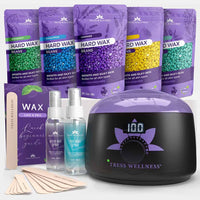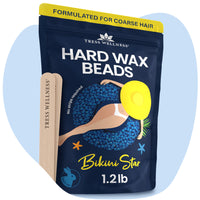If you’re wondering how long does bikini wax last, the answer is typically between three to four weeks. The duration can vary based on individual hair growth cycles, the type of wax used, and regularity of waxing. In this article, we’ll explore what impacts the longevity of your bikini wax and how you can maximize hair-free results.
Key Takeaways
-
Bikini waxes typically last about three to four weeks, but this varies based on individual hair regrowth rates and the type of wax used.
-
Factors like hair coarseness, hormonal imbalances, genetics, and recent shaving history can affect how long a bikini wax lasts.
-
Regular waxing weakens hair follicles over time, reducing regrowth and making future waxes less painful compared to shaving between sessions.

Understanding How Long a Bikini Wax Lasts
Bikini waxes, on average, last for about three-four weeks. However, the exact duration can vary based on individual hair regrowth rates. If you’re wondering why your friend’s bikini wax seems to last longer than yours, it’s likely due to differences in hair growth cycles.. So, if you’ve ever wondered, “How long does a Brazilian wax last?” the answer aligns closely with bikini waxes, generally speaking, around three to four weeks.
The type of wax used can also play a role. Hard wax, which is often preferred for sensitive areas like the bikini line, tends to provide longer-lasting results compared to soft wax. This is because hard wax adheres better to the hair, ensuring a cleaner pull from the root.
Your first wax might not last as long as subsequent waxes. This is because, initially, not all your hair is in the same growth phase. But don’t worry; with regular waxing appointments, you’ll notice that the results last longer over time.
Factors Affecting the Duration of a Bikini Wax
The duration of your bikini wax can be influenced by various factors:-
Type of Hair: Individuals with coarser hair may experience shorter-lasting results compared to those with finer hair. This is because coarse hair tends to grow back faster and more noticeably.
-
Hormonal Imbalances: Hormones affect hair growth cycles, and fluctuations can lead to faster regrowth, shortening the time you stay hair-free. For instance, during certain times of the month or due to specific health conditions, you might notice quicker hair regrowth.
-
Genetic Makeup: Your genetic makeup determines your hair growth rate and cycles. If you come from a family where rapid hair growth is common, you might find that your bikini wax results don’t last as long as you’d like.
-
Recent Shaving History: If you’ve been shaving frequently, the hair might be at different stages of growth, making it harder for the wax to remove all the hair effectively. To get the best results, it’s recommended to avoid shaving for at least a few weeks before your waxing appointment.
Hair Growth Phases and Their Impact on Wax Longevity

Understanding the phases of hair growth can help set realistic expectations for waxing results. There are three main phases: anagen, catagen, and telogen. Each phase impacts how long you stay hair-free after waxing.
-
Anagen Phase:
-
Active growth phase.
-
Hair is attached to the follicle and receives nutrients.
-
Waxing during this phase pulls hair out from the root, leading to longer-lasting results.
-
-
Catagen Phase:
-
Transitional period where hair growth stops.
-
Hair follicle begins to shrink.
-
Hair might grow back sooner after waxing as it’s more likely to break at the surface.
-
-
Telogen Phase:
-
Resting stage lasting between six weeks to six months.
-
Hair is ready to shed and be replaced by new growth.
-
Waxing during this phase can result in quicker regrowth since new hair is already forming beneath.
-
After about three to four waxes, all hairs should ideally be in the same growth cycle. This synchronization leads to more extended periods of smoothness and more consistent waxing results.
Common Issues: Ingrown Hairs and Skin Irritation
Common issues that you may encounter post-waxing include ingrown hairs and skin irritation. Ingrown hairs occur when hair curls back or grows sideways into the skin, often due to dry skin or breakage at the surface level during waxing.Ingrown hair can be bothersome, as they cause small, flesh-colored or reddish bumps that can be itchy, irritating, and occasionally painful. To prevent ingrown hairs, moisturizing the skin regularly is key. Keeping the skin hydrated helps to ensure that hair doesn’t break off at the surface during hair removal, such as waxing.
Another fundamental step for those with fine hair is exfoliation. Using a gentle exfoliant can help remove dead skin cells that clog hair follicles, reducing the risk of ingrown hairs. Products designed specifically for ingrown hair prevention can also be beneficial.
Lastly, avoid shaving between waxes. Shaving not only disrupts the hair growth cycle but can also lead to itching and ingrown hairs. Sticking to regular waxing appointments will help minimize these issues over time.
Why Consistent Waxing Matters
When it comes to waxing, maintaining a consistent routine is key. Regular waxing sessions weaken hair follicles over time, leading to slower hair regrowth and finer hair. This is why it’s recommended to wax every four to six weeks.
A significant benefit of regular waxing is the gradual reduction of pain. Your first wax might be the most uncomfortable, but subsequent sessions will be less painful as long as you don’t shave in between. Maintaining a year-round waxing routine helps manage hair growth and keeps the skin smoother for longer periods.
Regular waxing also helps in preventing common issues like ingrown hairs and skin irritation. By sticking to a consistent waxing schedule, you allow the hair to grow in sync, reducing the chances of ingrown hairs. To achieve these benefits, consider visiting a professional for waxing services.
It is also vital to refrain from shaving between waxes. Shaving can make the hair thicker and coarser, which is counterproductive to the benefits of regular waxing. For the best results, always wax regularly and avoid shaving.
The Role of Tress Wellness Bikini Star Beads

Tress Wellness Bikini Star Beads are a game-changer for those who prefer at-home waxing. These beads are specially formulated for sensitive areas like the bikini and Brazilian region, ensuring a more comfortable waxing experience.
The ease of use is one standout feature of Bikini Star Beads. They are designed to be beginner-friendly, making them perfect for those who are new to waxing at home. Despite being gentle, they are highly effective at removing hair in one application, providing salon-like results without the salon price tag.
Additionally, these beads have several benefits:
-
They are less painful compared to other hard wax beads, making them an excellent choice for sensitive areas.
-
For the best results, it’s recommended to keep the skin taut during application.
-
Follow up with soothing aftercare products like aloe vera gel.
These beads offer the following benefits:
-
Cost-effective alternative to professional waxing
-
Convenience of at-home waxing routine maintenance
-
Significantly improves at-home waxing experience for most women.
Summary
In summary, understanding how long a bikini wax lasts and the factors that influence its duration can help you achieve the best hair-free results. Factors such as hair type, hormonal imbalances, and genetics play significant roles in how long your wax lasts. Regular waxing weakens hair follicles, slows regrowth, and reduces post-waxing pain.
Tress Wellness Bikini Star Beads offer an excellent at-home solution for those looking to maintain their waxing routine comfortably and effectively. By following the tips and insights shared in this blog post, you can enjoy smoother, hair-free skin for longer periods.
Frequently Asked Questions
Does a bikini wax last longer than shaving?
Yes, a bikini wax lasts longer than shaving, lasting several weeks before you'll need another appointment. So, if you're looking for longer-lasting hair removal, waxing is the way to go!
How long does a bikini wax last?
A bikini wax typically lasts between three to four weeks, but it may vary based on individual hair regrowth rates.
What factors affect the duration of a bikini wax?
The duration of a bikini wax is affected by factors such as hair type, hormonal imbalances, genetics, and recent shaving history. These factors determine how long the wax lasts.
How do the phases of hair growth impact waxing results?
Waxing during the anagen phase of hair growth will give you the longest-lasting results, while waxing during the other phases may not be as effective.
How can I prevent ingrown hairs after waxing?
To prevent ingrown hairs after waxing, remember to moisturize regularly, exfoliate gently, and avoid shaving between waxes. These steps can help keep ingrown hairs at bay.




